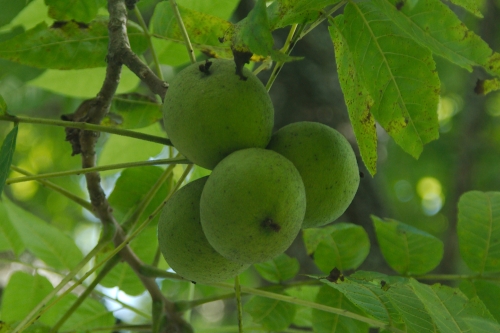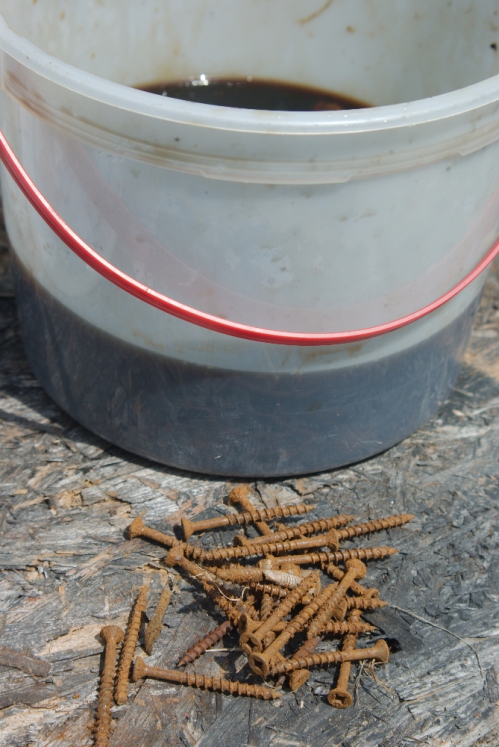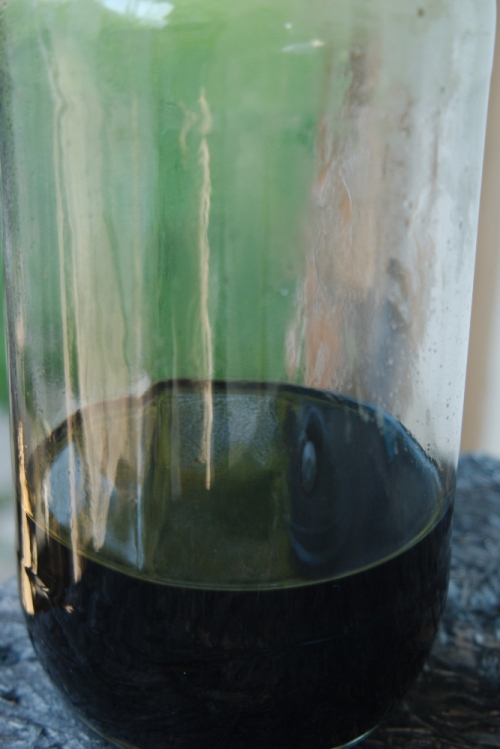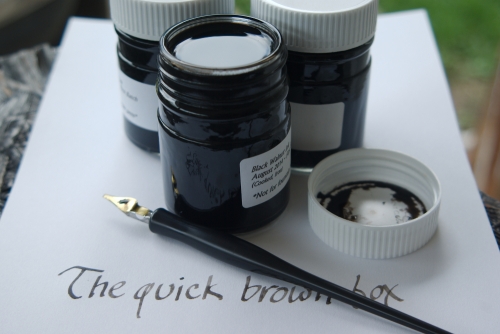Every year, our black walnut tree produces dozens and dozens of walnuts. I had heard that you can make ink from the husks, so I collected about ten of the walnuts that dropped early, put them in a plastic ice cream bucket, covered them with water and let them soak. After about a week I opened the bucket, broke up the husks and threw in a handful of rusty screws, which is supposed to make the ink darker, and soaked the mess for another week.
The next step is cooking. Since I didn’t want to stink up the house, I took my Coleman stove out to the back porch, filled it up and dumped the contents of the ice cream bucket into a thrift-store saucepan. I got it simmering and then turned it down just enough to keep it hot but not bubbling and cooked it for several hours.
I took it off the stove and let it cool and then poured it through a nylon stocking into a glass pickle jar to strain out the screws and walnut bits.
I cleaned up the saucepan (using the garden hose) and poured the strained ink back into it to cook it down to the desired color and consistency, testing it with a dip pen, and then strained it once more.
I had about 12 ounces of ink and I added a couple of ounces of denatured alcohol, which will help keep it from growing mold.
There are still a lot of black walnuts where these came from, so I will be doing at least one more batch. I might try one without the rusty screws – apparently the ink ends up a reddish brown color without the iron.
This is a messy project with the potential to stain anything it comes into contact with, so I did all of this outdoors and wearing a pair of hair-dye gloves.











Yes, I have heard that one can make ink from walnuts and you are the first person I know who had ever tried it. I enjoyed reading your post 🙂
LikeLike
Thank you! It was fun to make. Kind of reminded me of making mud-pies.
LikeLike
ditto !
LikeLike
This sounds so “old fashioned” and poetic! If I had walnuts and a garden , I would certainly try to make it!
And then I ‘d like to write with this magical ink , on my wishing-cards , on my kitchen-labels and maybe on the front page of a book , when making a present…..
The reddish brown ink would be my favorite!
H&K
LikeLike
Thank you, Anna! I just wrote a letter to a friend with it. Just to write a letter by hand felt old fashioned.
LikeLike
Big admiring wow!! Excellent photos too!!
LikeLike
Thank you, Cybele! Now I have to find my papermaking stuff so I can really be low-tech!
LikeLike
Well done, Ann! A grand project! I wonder if the ink could be used as a yarn dye.
LikeLike
Thank you! There was a mention, in one of the ink “recipes” I found, that black walnuts were used to make dye – both for fiber and hair. I’m going to leave out the iron in my next batch which should make the ink a rich reddish brown. It’s getting near sock-knitting season, so I will keep my eyes open for a skein of undyed homespun wool. I’ve never dyed yarn before, but I never made ink before either! Thanks for the great idea!
LikeLiked by 1 person
It would be a great color for the socks! I love all the shades of brown 🙂
LikeLike
So that’s what I can do with the vast number of black walnuts that turn my yard into a hard-hat zone each fall! Think I could run a printing press. Really enjoyed your informative post.
LikeLike
Yes! You have to use a dip pen – the ink will clog up a fountain pen, but otherwise, it’s perfectly serviceable ink. You only need the husks (the outer green part that turns black after the nut falls) so you can still keep the nuts for baking or whatever. I threw in the whole thing, since I don’t use walnuts for anything and it’s much easier.
LikeLike
you enterprising hard-working patient calculating so-&-so! come the wrevolooshin, or the RR/ZA, you’ll be the ONLY cartographer after a while … (RR/ZA: you know … robotrebellionzombyapocalypse)
LikeLike
Well, I’m two-thirds of the way there. I have to figure out the pen part next. I understand one needs molted goose or duck wing feathers. And I will go through a lot learning how to cut them. I don’t know about cartography though. I still get longitude and latitude mixed up.
LikeLike